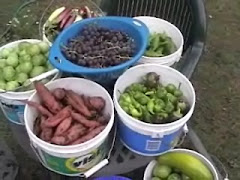
This past weekend we took a drive up into the mountains to see how the huckleberries were progressing this year...not so great. Berries were few and far between possibly due to the lengthy rainy weather this spring affecting their ability to pollinate properly, so we only picked a few to be used fresh this week. Hopefully we will have better luck higher up in the mountains later this summer in a few of our favorite spots. All was not lost though as we quickly switched gears and focused instead on gathering elderberry blossoms and the flowers of St. Johns Wort that were growing wild nearby.


Thanks to a couple of wonderful posts
here and
here from Diane over at
Peaceful Acres we recently and inadvertently discovered that St. John's Wort grows wild all around our area. It can be fairly easily identified via the purplish dots that appear to perforate the leaves and flowers which is where this plant gets it's name
Hypericum perforatum. So after reading her posts we are now happily following suite and making our own herbal salve.



We have also been picking and drying clover, violet flowers, chamomile, and even a few huckleberry leaves that we use fresh or dried in various potions and teas.

A light and refreshing sun tea in the works comprised of clover, huckleberry leaves, rose petals, mint, and lemon balm.

Various herbs drying in the greenhouse.

Drying North Idaho tea plant (huckleberry) leaves for winter use.:)

We recently identified this plant as Split-Lip Hemp Nettle (?), a member of the mint family, growing in our area. Not sure what we will be using it for as of yet...might be poisonous.(?)

 This past weekend we took a drive up into the mountains to see how the huckleberries were progressing this year...not so great. Berries were few and far between possibly due to the lengthy rainy weather this spring affecting their ability to pollinate properly, so we only picked a few to be used fresh this week. Hopefully we will have better luck higher up in the mountains later this summer in a few of our favorite spots. All was not lost though as we quickly switched gears and focused instead on gathering elderberry blossoms and the flowers of St. Johns Wort that were growing wild nearby.
This past weekend we took a drive up into the mountains to see how the huckleberries were progressing this year...not so great. Berries were few and far between possibly due to the lengthy rainy weather this spring affecting their ability to pollinate properly, so we only picked a few to be used fresh this week. Hopefully we will have better luck higher up in the mountains later this summer in a few of our favorite spots. All was not lost though as we quickly switched gears and focused instead on gathering elderberry blossoms and the flowers of St. Johns Wort that were growing wild nearby.
 Thanks to a couple of wonderful posts here and here from Diane over at Peaceful Acres we recently and inadvertently discovered that St. John's Wort grows wild all around our area. It can be fairly easily identified via the purplish dots that appear to perforate the leaves and flowers which is where this plant gets it's name Hypericum perforatum. So after reading her posts we are now happily following suite and making our own herbal salve.
Thanks to a couple of wonderful posts here and here from Diane over at Peaceful Acres we recently and inadvertently discovered that St. John's Wort grows wild all around our area. It can be fairly easily identified via the purplish dots that appear to perforate the leaves and flowers which is where this plant gets it's name Hypericum perforatum. So after reading her posts we are now happily following suite and making our own herbal salve.

 We have also been picking and drying clover, violet flowers, chamomile, and even a few huckleberry leaves that we use fresh or dried in various potions and teas.
We have also been picking and drying clover, violet flowers, chamomile, and even a few huckleberry leaves that we use fresh or dried in various potions and teas. A light and refreshing sun tea in the works comprised of clover, huckleberry leaves, rose petals, mint, and lemon balm.
A light and refreshing sun tea in the works comprised of clover, huckleberry leaves, rose petals, mint, and lemon balm. Various herbs drying in the greenhouse.
Various herbs drying in the greenhouse. Drying North Idaho tea plant (huckleberry) leaves for winter use.:)
Drying North Idaho tea plant (huckleberry) leaves for winter use.:) We recently identified this plant as Split-Lip Hemp Nettle (?), a member of the mint family, growing in our area. Not sure what we will be using it for as of yet...might be poisonous.(?)
We recently identified this plant as Split-Lip Hemp Nettle (?), a member of the mint family, growing in our area. Not sure what we will be using it for as of yet...might be poisonous.(?)





























































